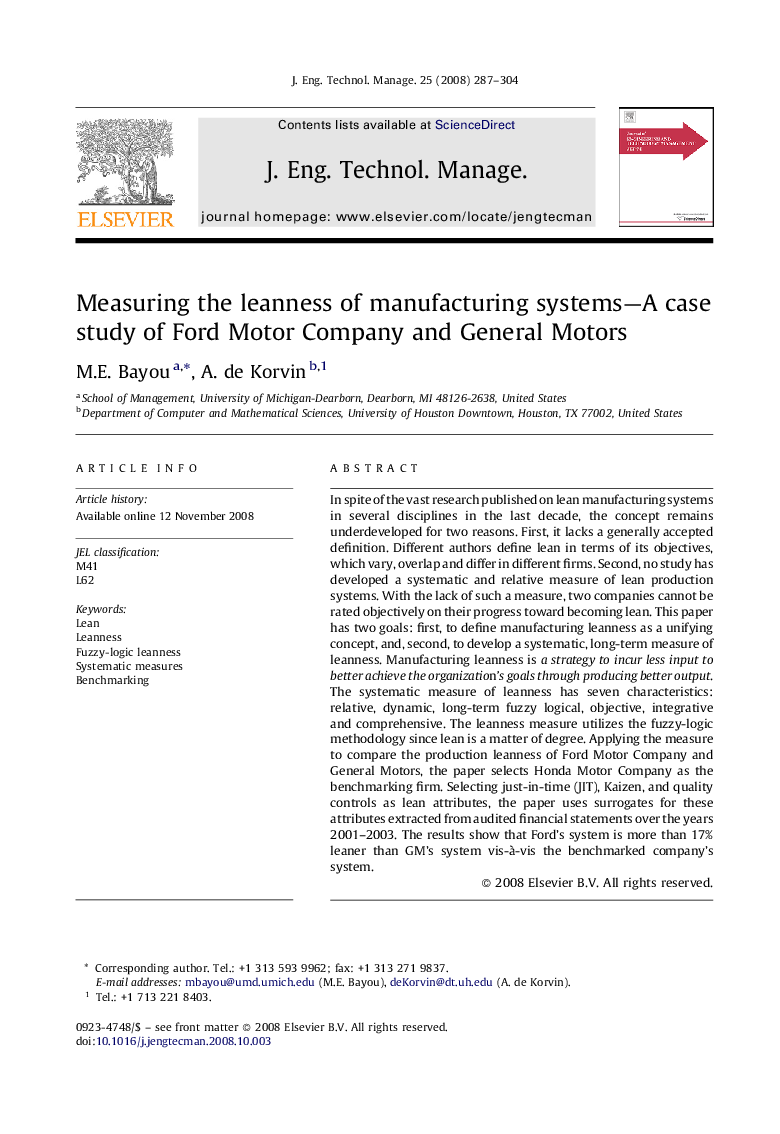| کد مقاله | کد نشریه | سال انتشار | مقاله انگلیسی | نسخه تمام متن |
|---|---|---|---|---|
| 1006430 | 938257 | 2008 | 18 صفحه PDF | دانلود رایگان |
عنوان انگلیسی مقاله ISI
Measuring the leanness of manufacturing systems—A case study of Ford Motor Company and General Motors
ترجمه فارسی عنوان
اندازه گیری ناب بودن سیستم های تولید __ مورد مطالعه از شرکت موتور فورد و جنرال موتورز
همین الان دانلود کنید
دانلود مقاله ISI انگلیسی
رایگان برای ایرانیان
کلمات کلیدی
ناب - ناب بودن سودمند -
ناب بودن سودمند منطق فازی - اقدامات نظام مند - تعیین معیار
فهرست مطالب مقاله
چکیده
مقدمه
تولید ناب چیست؟
ویژگیهای پیشنهادشده اندازه گیری نابی
الگوریتم اندازه گیری نابی
منطق فازی: مفاهیم اساسی
گزارههای کلیدی فازی
مدل نابی فازی و اطلاعات
شرکت محکزنی (موردمطالعه موردی)
اجزای فازی نابی
ویژگی فازی نابی
تجمیع ویژگیهای فازی
پیشنهادها برای تحقیقات آینده
خلاصه و نتیجهگیری
مقدمه
تولید ناب چیست؟
ویژگیهای پیشنهادشده اندازه گیری نابی
الگوریتم اندازه گیری نابی
منطق فازی: مفاهیم اساسی
گزارههای کلیدی فازی
مدل نابی فازی و اطلاعات
شرکت محکزنی (موردمطالعه موردی)
اجزای فازی نابی
ویژگی فازی نابی
تجمیع ویژگیهای فازی
پیشنهادها برای تحقیقات آینده
خلاصه و نتیجهگیری
ترجمه چکیده
باوجود تحقیقات گسترده منتشرشده در سیستم تولید ناب در چندین رشته در دهه گذشته، مفهوم آن به دو دلیل توسعه و ترقی پیدا نکرده است. اول به دلیل فقدآنیک تعریف کلی موردپذیرش است. نویسندگان مختلف برحسب اهداف موردنظرشان تعریف هایی بیان کرده اند که در شرکت های مختلف متنوع، دارای همپوشانی باهم و متفاوت هستند. دوم، هیچ مطالعه ای اندازه گیری سامانمند و نسبی از سیستم تولید ناب توسعه داده نشده است. با فقدان چنین اندازه گیری، دو شرکت نمیتوانند بهصورت واقعی پیشرفت خود را بهسوی تبدیلشدن به تولید ناب درجه بندی کنند. این مقاله دو هدف دارد: اول، تعریف تولید ناب بهصورت یک مفهوم یکی شده و دوم، توسعه و بسط دادن اندازه گیری نظام مند و طولانیمدت از تولید ناب. تولید ناب یک استراتژی بهمنظور خسارت متحمل شده کمتر ورودی برای دستیابی بهتر به اهداف سازمانی از طریق خروجی بهتر تولید است
موضوعات مرتبط
علوم انسانی و اجتماعی
مدیریت، کسب و کار و حسابداری
حسابداری
چکیده انگلیسی
In spite of the vast research published on lean manufacturing systems in several disciplines in the last decade, the concept remains underdeveloped for two reasons. First, it lacks a generally accepted definition. Different authors define lean in terms of its objectives, which vary, overlap and differ in different firms. Second, no study has developed a systematic and relative measure of lean production systems. With the lack of such a measure, two companies cannot be rated objectively on their progress toward becoming lean. This paper has two goals: first, to define manufacturing leanness as a unifying concept, and, second, to develop a systematic, long-term measure of leanness. Manufacturing leanness is a strategy to incur less input to better achieve the organization’s goals through producing better output. The systematic measure of leanness has seven characteristics: relative, dynamic, long-term fuzzy logical, objective, integrative and comprehensive. The leanness measure utilizes the fuzzy-logic methodology since lean is a matter of degree. Applying the measure to compare the production leanness of Ford Motor Company and General Motors, the paper selects Honda Motor Company as the benchmarking firm. Selecting just-in-time (JIT), Kaizen, and quality controls as lean attributes, the paper uses surrogates for these attributes extracted from audited financial statements over the years 2001–2003. The results show that Ford’s system is more than 17% leaner than GM’s system vis-à-vis the benchmarked company’s system.
ناشر
Database: Elsevier - ScienceDirect (ساینس دایرکت)
Journal: Journal of Engineering and Technology Management - Volume 25, Issue 4, December 2008, Pages 287–304
Journal: Journal of Engineering and Technology Management - Volume 25, Issue 4, December 2008, Pages 287–304
نویسندگان
M.E. Bayou, A. de Korvin,
